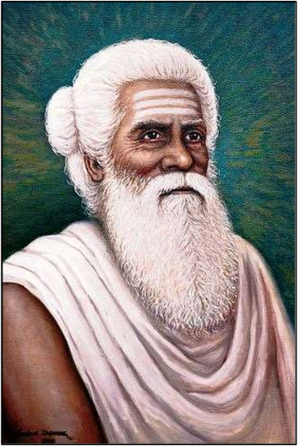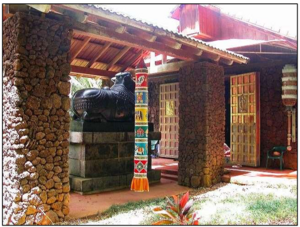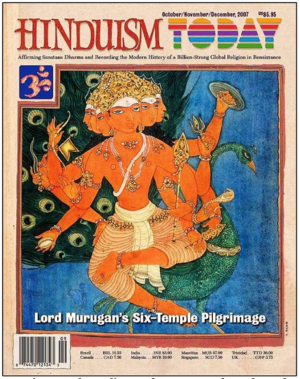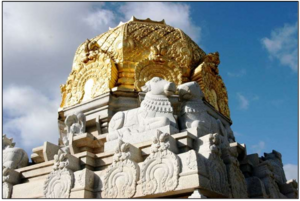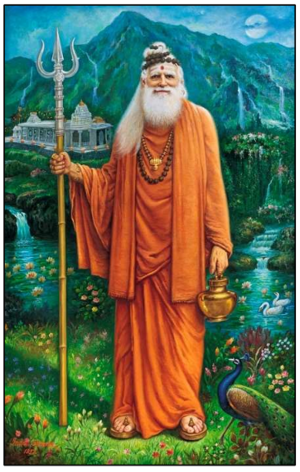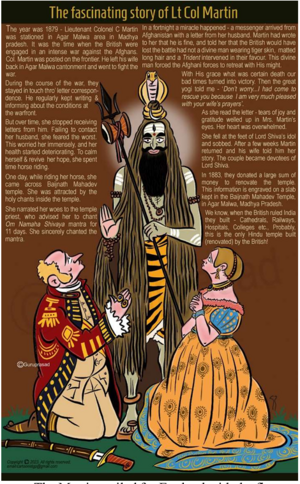Talk:National Origin
By Vishal Agarwal
Hūṇāḥ, Kirātāḥ, Pulindāḥ, Āndhrāḥ, Ābhīrāḥ, Kaṅkāḥ, Yavanāḥ, Khaśāś ca — yady apy anyeṣām jātayaḥ, te sarve tad-bhaktim āśritya ekī-bhavanti — tasmai Viṣṇave namaḥ. Bhāgavata Purāṇa 2.4.18
Swāmī Ghanānanda: Taking Hindu Dharm to Ghana (Africa) \[\[File\:Swami Ghanananda.png|thumb]] Swāmī Ghanānanda was born to Christian parents in Ghana, a country in western Africa. As a child, he tried to understand the mysteries of the universe through the Bible, but he was not satisfied. He happened to read some books on Hindu Dharm and decided to learn more about it. He traveled to R̥ṣikeśa, a holy Hindu city in India, where he met his Guru. He became a sannyāsin and took the name Swāmī Ghanānanda Sarasvatī. His Guru advised him to move back to Accra, the capital of Ghana, and start an āśrama there.
\[\[File\:A hindu ashram in Accra, the capital of Ghana,.png|thumb]] Initially, he faced some opposition from the local people. But soon, more and more people started visiting him to listen to his talks. Through donations, he started a mandira-cum-āśrama in 1975. It is said that as a result of his efforts, 2,000 residents of Ghana have become followers of Hindu Dharm, and attend worship at these temples regularly. The mandira today celebrates all major utsava-s and Africans can be frequently seen singing bhajana-s in Hindi and other bhāṣā-s.
Satguru Śivāya Subramuṇiyāsvāmī (1927–2001) \[\[File\:Satguru Sivāya Subramuniyāswāmī (Robert Hansen).png|thumb]]
Robert Hansen was born in Oakland (California) and spent his early childhood in California and Lake Tahoe (Nevada). He attended the Sunday Church school and asked his teachers several questions that they could not always answer. Therefore, he stopped attending the school. Unfortunately, he was orphaned at a very early age because his mother died when he was 10, and his father died when he was 12 years of age. He was adopted by a family friend who ran a dance school close to San Francisco. She specialized in Indian dances and her home and school had a very Indian environment in which the students experienced Indian food, paintings, and so on. Robert loved music and dance, and he soon became a very famous ballet dancer in San Francisco. However, he was always very attracted to Eastern religions. At the young age of 19, he quit his job at a famous dance theater. Instead, he accompanied another dance troupe to reach Śrī Laṅkā. On the island, his dance troupe gave many performances. He also met with many Bauddha bhikṣu-s, Muslim holy men, and sādhus. Finally, a friend took him to Jaffna in northern Śrī Laṅkā, where he experienced Hindu culture firsthand.
He visited numerous mandira-s and met Svāmī Yogasvāmī (1872–1964)
who was a very famous living saint. The Guru gave Robert a new name – Subramuṇiya. Although he met his Guru only three times, Svāmī Yogasvāmī indicated that he wanted Subramuṇiya to be the leader of his branch of Hindu Dharm after him. This branch of Hindu Dharm is called the Kailāśa Sampradāya of the Nandinātha Paramparā. Subramuṇiya became a sannyāsī and returned to the United States when he was barely 22 years old.
Back in the United States, he spent the next 7 years in meditation following his Guru’s command. Then, in 1957, he founded America’s first Maṇḍira in San Francisco. Many people who were not dissatisfied with Christianity became his students and learned meditation from him. As Hindu Dharm was not very well known in the area then and Subramuṇiyā did not want to scare his students, he first named his organization as if it were a Christian Church. But after a few years, he realized that what he taught was Hindu Dharma, and therefore he insisted that his students give up their Christian practices and live like Hindus.
In 1970, he purchased a 458-acre plot of land on the island of Kauai in Hawaii and founded an Āśrama. His students moved to their new location and constructed the monastery, a beautiful temple named Kadavul Temple, and started growing their food. He asked all his students to formally follow Hindu Dharm. He wrote a booklet called How to Become a Hindu, which contains guidelines on how non-Hindus can leave their religion and adopt Hindu Dharm.
Subramuṇiyā now headed an Āśrama, and because his Guru Yogasvāmī chose him as his successor to lead several hundred thousand Śaivite of Sri Lanka. Therefore, he came to be known as Satguru Sivāya Subramuṇiyāsvāmī. When he traveled to distant countries like Malaysia and Mauritius, he was welcomed by thousands of people who showered flowers at him and took him in massive processions. During these tours, he noticed that Hindus were being harassed by members of other religions, and were being asked to become Christians and Muslims. Hindu Dharm teaches us to respect all religions, but some Hindus have the wrong belief that all religions are equal. Moreover, our Dharm teaches us to respect teachers and priests of all religions. But, Christian and Muslim priests often abuse our hospitality and start pressuring their Hindu hosts to convert. When the Satguru saw this, he taught the Hindus, All religions are not equal. Hindu Dharm is the greatest religion. Being hospitable to Christian and Muslim priests does not mean that we continue to be polite to them even when they abuse our religion. Be proud of our Hindu Dharm and worship Śiva. Never give up Hindu Dharm to convert to any other religion.
Satguru and his students saw that most Hindus were ignorant of our own Dharm, and were divided into many groups depending on which country we were from, what language we spoke, and which caste we belonged to. Therefore, in 1979, he started publishing a beautiful magazine called Hinduism Today in which the articles covered Hindu Dharm as practiced not only in India but in every country, and within every tradition. He also helped start more than 50 Maṇḍiras in the world. He wrote a 3000-page long course in three massive books that explain the basics of Hindu Dharm to Westerners. He represented Hindu Dharm in many conferences and meetings and received many awards. He founded websites like www.hindu.org and www.himalayanacademy.org. In 2001, he was diagnosed with cancer. He decided to follow the ancient path of Ṛṣis and refused medical treatment. Instead, he fasted for 32 days and his Ātman then merged with Śiva. His work is being continued by his successor Gurudeva Bodhinātha Veylānsvāmī and other Sannyāsīs.
Visitors to the island of Kauai in Hawaii are charmed by the beautiful monastery that Satguru Subramuṇiyāsvāmī had constructed. Money is being collected to complete the construction of a beautiful Śiva temple (Iraivan Temple) nearby. In the Āśrama, several trees produce the rare Rudrākṣa beads that the devotees of Śiva like to wear. The Kauai Āśrama makes bracelets and necklaces from these beads for Śiva-bhaktas.
In the United States, Hindu Dharm is described in very insulting and negative ways in textbooks that are used in schools and colleges. The Svāmīs of the Himalayan Academy are trying to correct this problem by meeting with government officials, pointing out the errors in these books, and publishing their books, magazines, and pamphlets that give a correct picture of our Dharm. The Svāmīs also travel all over the world educating the Hindus about Dharm. They are very good at technology and have produced beautiful movies and presentations for this purpose. They have printed a series of booklets that are used in schools all over the world to teach what our Dharm is about to students.
The example of Satguru Sivāya Subramuṇiyāsvāmī shows that one does not have to be from India to be a Guru because our Dharm is an eternal and universal religion that comes directly from Bhagavān who has created this entire universe.
From the Satguru and the Svāmīs after him, we also learn how we must use modern technology to teach others about our own Dharm in an attractive way. Finally, their publications teach us that all are one big family no matter which country we have come from. This is because their books and websites have articles, information, and pictures related not only from India but also from many other countries in all the continents of the world.
Story - Śiva temple built by the British
The British ruled India for hundreds of years and built many churches and cathedrals. But in the 1880s, a Śiva temple in Āgar Malvā, Madhya Pradesh, was rebuilt by Lt Col Martin — the only temple ever made by an Englishman in India.
Col Martin was in the Afghan wars. He used to regularly write to his wife, informing her of the conditions there. It was a long war, and gradually the colonel’s letters stopped. Mrs. Martin, who then lived in the cantonment of Āgar Malvā, was beside herself with grief, fearing the worst.
She would spend time riding for hours to calm herself. One day she rode her horse, past the temple of Baijnātha Mahādeva. It was in a decrepit state. It was the time of Ārati, and the sound of conches and the chanting of Mantras compelled her to stop. She went inside to see the worship of Lord Śiva taking place. The priests saw the grief on her face and asked her what was wrong. Mrs. Martin narrated her sad story. The Brāhmaṇas told her that Lord Śiva listens to the sincere prayers of all devotees and saves them from difficult situations. She was advised by one of the priests to start chanting the Mantra: Om Namaḥ Śivāya for 11 days. The Englishwoman prayed to Lord Śiva for the colonel’s safe return, promising she would rebuild the temple if he came home safe from the war.
On the 10th day, a messenger arrived from Afghanistan with a letter from her husband. It read, “I was regularly sending you letters from the battlefield but then suddenly the Pathāns surrounded us. I thought there was no way of escape. Suddenly I saw an Indian Yogī with long hair, wearing a tiger skin carrying a trident. He had an awe-inspiring personality and he started wielding his weapon against the Afghans who ran away from the field in fright. With his grace what was certain death our bad times turned into victory. Then the great Yogī told me that I should not worry and that he had come to rescue me because he was very pleased with my wife’s prayers.”
Tears of joy and gratitude welled up in Mrs. Martin’s eyes as she read the letter. Her heart was overwhelmed. She fell at the feet of Lord Śiva’s idol and sobbed. After a few weeks, Lt Col Martin returned and his wife told him her story. The couple became devotees of Lord Śiva. In 1883, they donated ₹15,000 to renovate the temple. This information is engraved on a slab kept in the Baijnātha Mahādeva Temple.
The Martins sailed for England with the firm resolution that they would make a Śiva temple at their home and pray to him till the end of life. And they did.[1]

